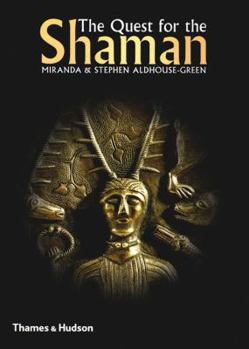The Quest for the Shaman
Here is an exciting, innovative study of ancient European religious practice and practitioners. The Aldhouse-Greens' entertaining and informative book represents a search, a voyage of discovery in... This description may be from another edition of this product.
Format:Hardcover
Language:English
ISBN:0500051348
ISBN13:9780500051344
Release Date:June 2005
Publisher:Thames & Hudson
Length:240 Pages
Weight:0.40 lbs.
Dimensions:1.1" x 6.9" x 9.9"
Customer Reviews
2 ratings
BOOK REVIEW: QUEST FOR THE SHAMAN
Published by Thriftbooks.com User , 18 years ago
Quest For The Shaman Miranda and Stephen Aldhouse-Green New York, Thames and Hudson, 2005 In 1861, archaeologists in what is now known as the Czech Republic uncovered a burial site known as Brno 2. Among the artifacts associated with the isolated remains were a reindeer antler with a polished end and a hematite necklace. Contemporary anthropologists claim that these items were routinely worn or used by ancient shamans. The grave is 24,000 years old; and, that's just one of the many facts that you'll discover when you read Miranda and Stephen Aldhouse-Green's Quest For The Shaman, a new publication from earlier this year. According to this esteemed pair of anthropology professors from the University of Wales in Newport, the word "shaman" is an old word itself, originating some 20,000 years ago with the Siberian Tongus peoples who eventually migrated to both Americas beginning about 9000 BC and culminating their colonizations in Iceland, having travelled across the rim of the Arctic Circle and steppe-tundra regions around 2000 years ago. Immediately, two questions arose in this reviewer's mind. We know, for example, that the Vikings took Celtic wives when they colonized Iceland, which began in earnest around 870 AD. Did they adopt shamanistic ideologies from the Aleuts who apparently evolved from the ancient Dorset people or did the Celts already possess shamanistic narratives? If so, how did they get them? The first written encounter between Aleuts and Vikings ended in eight out of the nine former Inuit dead because the colonists wanted to see if the indigenous population were indeed human and bled like "normal people;" so, the chances of an ideal cultural exchange occurring between these two societies was undoubtedly rare. Most Celtic myths, unfortunately, are translations of medieval copies, which we know are contaminated with other religious philosophies. The second question revolves around cosmetic issues. First, we also know that shamanism was only one of several religions conducted by the Siberian Tongus and the ritualism centered around the life cycle of reindeer. How did this particular religious philosophy eventually dominate many ancient cultures (or did it in fact actually dominate that much?); and what happened to all the reindeer imagery after being established in the New World following the extinction of most of the large land mammals? Well, for one thing, giant elk are known as red deer in some parts, particulaly in the British Isles, so these beasts undoubtedly replaced the original denizens. Around the Arctic Circle, without four-legged furries, they apparently replaced the whole deer theme and sang the world's first version of "I Am the Walrus." If you can wrap your brain around the migration inconsistencies, Quest For The Shaman makes much more sense. But, be warned. If phrases like "it may be possible to suggest" irritate you to no end, then you might not like this book as much. There's also some con
. . . or maybe not
Published by Thriftbooks.com User , 18 years ago
Let me start by saying I thoroughly enjoyed reading this book, since there will be some negative comments below. The Aldhouse-Green's guide us through a panoramic tour of human history from the Paleolithic to the Middle Ages. They take us to caves, rock faces, and grave sites where there is material culture to be viewed. They present many interesting theories about how various artifacts can be explained by references to shamanism. Unfortunately, the theories are primarily speculation that could easily be explained in alternate ways. As an example, they make a credible case for the religious significance of liminal (i.e. edgy---like rock faces, caves, shorelines, etc.) locations. They examine a particular case of handprints on a cave wall and "wonder . . . whether the hands depicted were reaching out to or from the world of spirits." This is interesting speculation, as long as we don't apply similar analysis to finger painting sessions in kindergarten. There is simply no way to know. And so it is with virtually all of the explanations in this otherwise interesting book. If you are looking for hard answers, look elsewhere. One niggling point is the production of the book. The paper is extremely heavy, thick, and shiny. Its shine produces reflections that sometimes make it hard to read when the light is directly behind you. That said, this book is very interesting, the speculations are clearly labeled as such, and I learned a great deal from reading it.





